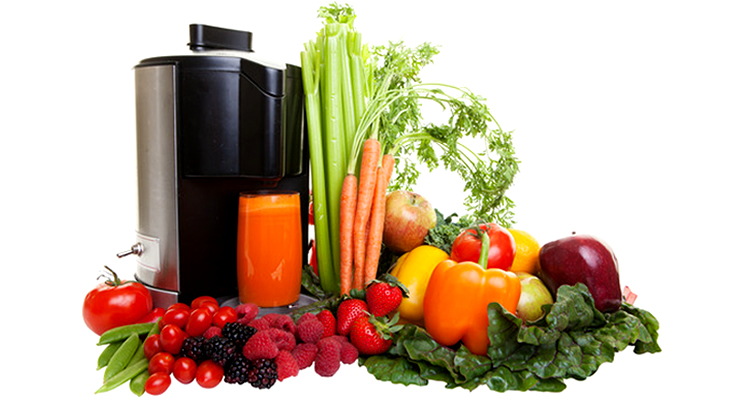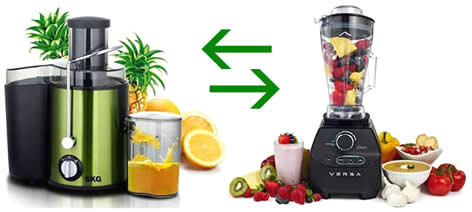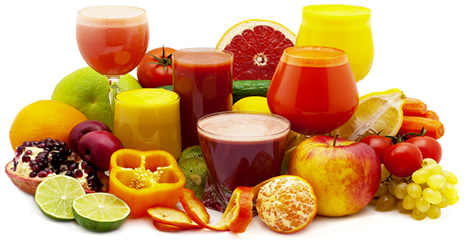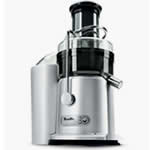
Whether you’re looking into juicing as a way to lose weight, to maintain your current size or just to incorporate more nutrient-rich foods into your family’s diet, the liquid approach for eating more fruits and vegetables can provide a number of great benefits. With a little bit of effort in the kitchen; and perhaps with more trips to the produce section than you’re currently used to making, juicing can become a natural and beloved part of your eating routine.
Understanding the difference between juicing and blending
 What’s the distinction between juicing and blending?
What’s the distinction between juicing and blending?
When chatting with friends or reading a cooking blog, we often hear or see the terms “juicing” and “blending” used interchangeably. Even infomercials for high-end blenders will use the word juicing to describe the actions of their machines. Although pointing out the two separate terms may seem grammatically picky, there’s actually a big nutritional difference between juicing foods, which separates the pulp from the liquid, and blending foods, which liquefies whole foods and doesn’t remove any of the fiber or nutrients.
Which liquefying approach is better for my health?
When you separate the liquid from the pulp during the juicing process, you leave behind the fiber and you increase the proportion of remaining components like sugar. Juicing and blending each have their pros and cons so neither is universally better and a comprehensive approach to healthy eating may feature both types of liquefying at various points throughout your week. If you’re only going to have one machine, I personally think a blender is more advantageous, but you may find a juicer to be more useful given your specific goals and lifestyle.
Do most of the health benefits apply to both approaches?
Besides the differing nutrient content, most of the benefits to juicing and blending are the same so our look today at the positive effects of juicing can help you get an idea of how blending could help your life as well.
Regardless of what methods you choose to incorporate more fruits and vegetables into your world, I hope you find a great solution that serves you and your family wonderfully.
What can juicing do for me?
 1. Provides necessary hydration
1. Provides necessary hydration
Drinking a glass of juice can quench your thirst in a way that eating a bowl of spinach can’t. Juicing helps you take advantage of nature’s liquids without having to solely drink plain water day in and day out. Homemade fruit and vegetable juices still have calories so the fun beverages don’t make for a great go-to every time you’re feeling parched, but the do-it-yourself drinks can deliver some extra hydration bonus points, which can serve you well when featured along with a diligent consumption of plain water.
2. Eases digestion
When you’re having digestive problems, detox diets often recommend juicing to help soothe your symptoms and lessen the demands on your digestive tract. Sticking to liquid meal replacements can help lighten the load your system has to endure when breaking down components for the bioavailability of all the vitamins and minerals your body needs to function well. Even when you’re not replacing every meal with a fruit or veggie juice, the times you do drink a glass of liquid instead of eating a bowl of food can help you feel light and carefree as opposed to bloated, cramped and uncomfortable.
3. Gives a quick boost of energy
Because juicing separates the liquid from the fibrous pulp, a glass of juice acts like instant energy for your body. Your system doesn’t have to process the fiber so your body can immediately access the carbohydrates it needs to make you feel energetic and ready to go. Obviously, the downside of juicing becomes apparent during those times when you do want more fiber so be sure to proceed accordingly, making a blended shake sometimes or choosing to just eat the whole foods raw.
4. Supplies natural nourishment
Through juicing fresh fruits and vegetables, you can instantly access a host of essential vitamins, minerals and antioxidants necessary to keep your body nourished and healthy. Few of us can imagine eating serving after serving of plain vegetables like spinach, carrots and cabbage, but juicing can make it all happen without our minds or taste buds even recognizing what’s going on.
Combining vegetables and fruits in a three-to-one ratio is a great guide for keeping your juices packed with nutritional power and arming your body with the goods it needs to keep you on the straight and narrow track to a healthier you.
5. Avoids chemicals, artificial additives & unwanted calories
When juicing fresh fruits and vegetables you avoid all the problems that come with bottled options, which often feature chemical preservatives, artificial additives and extra calories from throw-in-at-the-end products like sugar. You’re in complete control when you do it yourself, enabled to skip the junk and just say no.
If you do ever want to add in extra ingredients like honey or almond milk to your juices, you certainly can, but add-ins should always be on your terms and not that of some manufacturer who doesn’t care what you and your family put into your bodies.
What kind of juicer should I buy?
 There are hundreds of juicers to choose from and the best pick really is a personal decision. High-end options may cost anywhere from one hundred to five hundred dollars so do your research and set your budget. Because juicing helps your health and nutrition, buying an appliance that enables good habits is a long-term investment. Many juicers even come with a multiple-year warranty so you can have a bit more confidence when taking the plunge and shelling out all that hard-earned money.
There are hundreds of juicers to choose from and the best pick really is a personal decision. High-end options may cost anywhere from one hundred to five hundred dollars so do your research and set your budget. Because juicing helps your health and nutrition, buying an appliance that enables good habits is a long-term investment. Many juicers even come with a multiple-year warranty so you can have a bit more confidence when taking the plunge and shelling out all that hard-earned money.
Once you’ve committed yourself to devoting a chunk of financial resources to the cause, read product reviews and comparisons to make sure you’re settling on a product that meets your needs. Some juicers take longer than others to get the job done. Determine your priorities and buy accordingly. Best wishes!
Leave a Reply